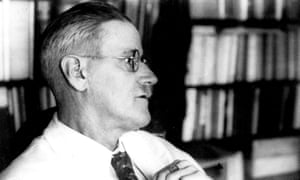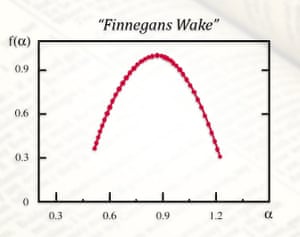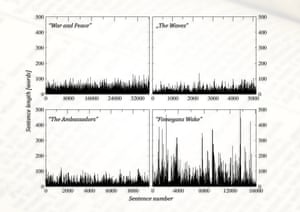
Scientists find evidence of mathematical structures in classic books
Researchers at Poland’s Institute of Nuclear Physics found complex
‘fractal’ patterning of sentences in literature, particularly in James
Joyce’s Finnegans Wake, which resemble ‘ideal’ maths seen in nature
 |
| James Joyce |
The academics put more than 100 works of world literature, by authors from Charles Dickens to Shakespeare, Alexandre Dumas, Thomas Mann, Umberto Eco and Samuel Beckett, through a detailed statistical analysis. Looking at sentence lengths and how they varied, they found that in an “overwhelming majority” of the studied texts, the correlations in variations of sentence length were governed by the dynamics of a cascade – meaning that their construction is a fractal: a mathematical object in which each fragment, when expanded, has a structure resembling the whole.
“All of the examined works showed self-similarity in terms of organisation of the lengths of sentences. Some were more expressive – here The Ambassadors by Henry James stood out – others to far less of an extreme, as in the case of the French 17th-century romance Artamene ou le Grand Cyrus. However, correlations were evident, and therefore these texts were the construction of a fractal,” said Dr Paweł Oświęcimka from the Institute of Nuclear Physics of the Polish Academy of Sciences, one of the authors of the new paper Quantifying Origin and Character of Long-range Correlations in Narrative Texts.
Some works, however, were more mathematically complex than others, with stream-of-consciousness narratives the most complex, comparable to multifractals, or fractals of fractals. Finnegans Wake, the scientists found, was the most complex of all.
“The absolute record in terms of multifractality turned out to be Finnegans Wake by James Joyce. The results of our analysis of this text are virtually indistinguishable from ideal, purely mathematical multifractals,” said Professor Stanisław Drożdż, another author of the paper, which has just been published in the computer science journal Information Sciences.
 |
| Photo: IFJ Pan |
The academics write in their paper that: “Studying characteristics of the sentence-length variability in a large corpus of world famous literary texts shows that an appealing and aesthetic optimum … involves self-similar, cascade-like alternations of various lengths of sentences.”
 |
| Sequences of sentence lengths (as measured by number of words) in four books, representative of various degrees of cascading character. Photograph: IFJ PAN |
The other works most comparable to multifractals, the academics
found, were A Heartbreaking Work of Staggering Genius by Dave Eggers,
Hopscotch by Julio Cortazar, The USA trilogy by John Dos Passos, The
Waves by Virginia Woolf, 2666 by Roberto Bolaño and Joyce’s Ulysses.
Marcel Proust’s À la recherche du temps perdu showed “little
correlation” to multifractality, however; nor did Ayn Rand’s Atlas
Shrugged.
The academics note that “fractality of a literary text will in practice never be as perfect as in the world of mathematics”, because a mathematical fractal can be magnified to infinite, while the number of sentences in a book are finite.
“It is not entirely clear whether stream-of-consciousness writing actually reveals the deeper qualities of our consciousness, or rather the imagination of the writers. It is hardly surprising that ascribing a work to a particular genre is, for whatever reason, sometimes subjective,” said Drożdż, suggesting that the scientists’ work “may someday help in a more objective assignment of books to one genre or another”.
Drożdż suggested today that the findings could also be used to posit that writers “uncovered fractals and even multifractals in nature long before scientists”. “Evidently, they (like Joyce) had a kind of intuition, as it happens to great artists, that such a narrative mode best reflects ‘how nature works’ and they properly encoded this into their texts,” he said. “Nature evolves through cascades and thus arranges fractally, and imprints of this we find in the sentence-length variability.”
Eimear McBride, whose multiple award-winning debut novel A Girl is a Half-Formed Thing is written in a stream-of-consciousness style, said she wasn’t taken aback by the results.
“It doesn’t surprise me that works described as “stream of consciousness” appear to be the most fractal. By its nature, such writing is concerned not only with the usual load-bearing aspects of language – content, meaning, aesthetics, etc – but engages with language as the object in itself, using the re-forming of its rules to give the reader a more prismatic understanding of the subject at hand. Given the long-established connection between beauty and symmetry, finding works of literature fractally quantifiable seems perfectly reasonable.”
But she added that she couldn’t “help being somewhat disappointed by the idea that the main upshot of this research may be to make the assigning of genre more straightforward”.
“Surely there are more interesting questions about the how and why of writers’ brains arriving at these complex, but seemingly instinctive, fractals?” she said. “And, given Professor Drożdż’s pretty inarguable contention that it remains unclear whether or not stream-of-consciousness writing does indeed reveal a deeper layer of consciousness, what distance this research may go to explain why some readers believe themselves to be experiencing exactly that while others have the opposite reaction?”
The academics note that “fractality of a literary text will in practice never be as perfect as in the world of mathematics”, because a mathematical fractal can be magnified to infinite, while the number of sentences in a book are finite.
“It is not entirely clear whether stream-of-consciousness writing actually reveals the deeper qualities of our consciousness, or rather the imagination of the writers. It is hardly surprising that ascribing a work to a particular genre is, for whatever reason, sometimes subjective,” said Drożdż, suggesting that the scientists’ work “may someday help in a more objective assignment of books to one genre or another”.
Drożdż suggested today that the findings could also be used to posit that writers “uncovered fractals and even multifractals in nature long before scientists”. “Evidently, they (like Joyce) had a kind of intuition, as it happens to great artists, that such a narrative mode best reflects ‘how nature works’ and they properly encoded this into their texts,” he said. “Nature evolves through cascades and thus arranges fractally, and imprints of this we find in the sentence-length variability.”
Eimear McBride, whose multiple award-winning debut novel A Girl is a Half-Formed Thing is written in a stream-of-consciousness style, said she wasn’t taken aback by the results.
“It doesn’t surprise me that works described as “stream of consciousness” appear to be the most fractal. By its nature, such writing is concerned not only with the usual load-bearing aspects of language – content, meaning, aesthetics, etc – but engages with language as the object in itself, using the re-forming of its rules to give the reader a more prismatic understanding of the subject at hand. Given the long-established connection between beauty and symmetry, finding works of literature fractally quantifiable seems perfectly reasonable.”
But she added that she couldn’t “help being somewhat disappointed by the idea that the main upshot of this research may be to make the assigning of genre more straightforward”.
“Surely there are more interesting questions about the how and why of writers’ brains arriving at these complex, but seemingly instinctive, fractals?” she said. “And, given Professor Drożdż’s pretty inarguable contention that it remains unclear whether or not stream-of-consciousness writing does indeed reveal a deeper layer of consciousness, what distance this research may go to explain why some readers believe themselves to be experiencing exactly that while others have the opposite reaction?”
So what does this have to do with the Flipside you ask?
A bit hard to digest. But scientists have put the "number of words in a sentence" to measure recurring length in great works of art, and discovered that many are fractals - a mathematical structure that has within it, a repeated sequence.
In this dense article, they argue that somehow great artists tap into "unconscious" fractals - and call Joyce's "Finnegan's Wake" the ultimate in "Stream of consciousness writing."
Here's the thing. In my "Flipside" and "It's a Wonderful Afterlife" research, people talk about seeing "fractals" while under deep hypnosis, and when asked to describe the contents of these "geometric shapes" that appear to follow people around, one claimed they were like "external hard drives that contain all the memories of our previous lifetimes."
Another claimed they contain "ancient information." And now here is the Guardian quoting Polish scientists saying that fractals are not only inherent in nature (snowflakes) but also in art. As if we have the code of fractal creation somewhere in our consciousness, we may not be aware of it, but it appears in our art.
Next up would be to examine other works of art to see if this pattern repeats itself. "What's the point?" you might ask? It's that consciousness isn't confined to the brain. And if that's true, then everything we think we know about the planet is off, wrong. A fundamental rethink is in order. Don't shoot the messenger. A fractal is defined as: a curve or geometric figure, each part of which has the same statistical character as the whole. Fractals are useful in modeling structures (such as eroded coastlines or snowflakes) in which similar patterns recur at progressively smaller scales, and in describing partly random or chaotic phenomena such as crystal growth, fluid turbulence, and galaxy formation."
Turns out that we too are working within the fractal universe, but just aren't aware of it.
Until now.
Here's an interesting headline, that I've been mentioning in all of my books:
A 69-year-old monk who scientists call the 'world's happiest man' says the secret to being happy takes just 15 minutes a day
| Matthieu Ricard |
Matthieu Ricard, the world's happiest man.
Matthieu Ricard, 69, is a Tibetan Buddhist monk originally from France who has been called "the world's happiest man."
That's because he participated in a 12-year brain study on meditation and compassion led by a neuroscientist from the University of Wisconsin, Richard Davidson.
Davidson hooked up Ricard's head to 256 sensors and found that when Ricard was meditating on compassion his mind was unusually light.
Simple Capacity details the findings:
The scans showed that when meditating on
compassion, Ricard’s brain produces a level of gamma waves – those
linked to consciousness, attention, learning and memory – ‘never
reported before in the neuroscience literature’, Davidson said. The
scans also showed excessive activity in his brain’s left prefrontal
cortex compared to its right counterpart, allowing him an abnormally
large capacity for happiness and a reduced propensity towards
negativity.
He spoke with Business Insider at the World Economic Forum in Davos, Switzerland. Here's his advice for how to be happy.
Stop thinking 'me, me, me'
To Ricard, the answer comes down to altruism. The reason is that, thinking about yourself and how to make things better for yourself all the time is exhausting and stressful, and it ultimately leads to unhappiness."It's not the moral ground," Ricard says. "It's simply that me, me, me all day long is very stuffy. And it's quite miserable, because you instrumentalize the whole world as a threat, or as a potential sort of interest [to yourself]."
If you want to be happy, Ricard says you should strive to be "benevolent," which will not only make you feel better but also make others like you more.
That's not to say you should let other people take advantage of you, Ricard warns, but you should generally strive to be kind within reason.
"If your mind is filled with benevolence, you know, the passion and solidarity ... this is a very healthy state of mind that is conducive to flourishing," Ricard says. "So you, yourself, are in a much better mental state. Your body will be healthier, so it has been shown. And also, people will perceive it as something nice."
That all sounds great in theory, but how does a person actually become altruistic and benevolent and not let selfish thoughts creep in?
Start training your mind like you'd train to run a marathon
Ricard believes everyone has the ability to have a lighter mind because there's a potential for goodness in every human being (unless you're, say, a serial killer, and there's something actually chemically abnormal going on with your brain).But like a marathon runner who needs to train before he or she can run 26.2 miles, people who want to be happier need to train their minds. Ricard's preferred way of training his is meditation:
"With mental training, we can always bring
[our level of happiness] to a different level. It's like running. If I
train, I might run a marathon. I might not become an Olympic champion,
but there is a huge difference between training and not training. So why
should that not apply to the mind? ... There is a view that
benevolence, attention, emotional balance and resilience are skills that
can be trained. So if you put them all together, you could say that
happiness is a skill that can be trained.
Just spend 15 continuous minutes a day thinking happy thoughts
Start by thinking happy thoughts for 10 to 15 minutes a day, Ricard says. Typically when we experience feelings of happiness and love, it's fleeting and then something else happens, and we move on to the next thought. Instead, concentrate on not letting your mind get distracted, and keep focused on the positive emotions for the next stretch of time.And if you do that training every day, even just two weeks later you can feel positive mental results. And if you practice that for 50 years like Ricard has, you can become a happiness pro too. That's backed up by neuroscientists, by the way. Davidson found in his study that even 20 minutes of daily meditation can make people much happier overall.
_______________________________________
I asked Richard Davidson what specific meditation he used in the epic Univ of Wisconsin study.
"Tonglen" he told me. "But a non specific version." Meaning instead of the traditional Tibetan Buddhist meditation (paraphrasing) where you imagine a person who is ill and then you "call upon the healing light of the universe" to draw the illness (anger, sickness, rage) from them into you, and as it comes into you, you transform it into healing energy and breathe that energy back into them - instead of visualizing a person, the monks visualized the planet as a sick patient.
So focusing on losing the word "me" "mine" and "I" is one way of eliminating self focus, but the other way is to actually think of people you love (or don't love, depending) who are in need of a cure, and you visualize yourself helping to facilitate that cure. The point is simple; Science proves that by doing so you can "cure or eliminate symptoms of depression" in yourself.
There's no evidence that the meditation cures or helps the other person, (or prayer for that matter, but it can't hurt) but there is science that absolutely proves that it can cure depression. Literally "loving your neighbor as yourself" affects the amygdala, the part of the brain where depression resides.
Davidson says that even "one session of meditation" (or tonglen) can change the physical shape of the amygdala. Should be included/required in every doctor's kit bag; every school yard; ten minutes a day cures or alleviates symptoms of depression (and eventually replaces medications involved with amygdala suppression (SSRI drugs like zoloft and prozac) which as we know, in some people, some children, have dangerous side effects (suicide/violent acts).
Let me say it again. Ten minutes a day. Cure (or alleviate symptoms of) depression. Not a fad. Not a religion. Not a philosophy. It's free. It's science. It's data with proven results.
("Is this mic on?")
 |
| A sunset from a year ago.... |
An old sunset from a year ago.
Does a foto capture a slice of time the way a piece of a hologram carries all the info of the object?
If so, everything in a foto still exists, just have to figure out a way to access it, or tune ourselves to it. Virtual reality may be useful, using the senses to recreate an experience, or retain info from a place or person.
If they still exist, then creating an environment they could access would be key to hearing, seeing them. That is, a field where those outside of time could revisit old information... or loved ones.
My two cents.







